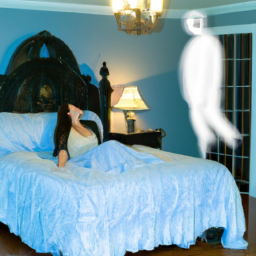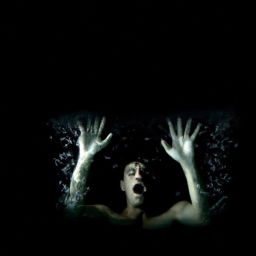Recently, I have been having a recurring dream that always features my boyfriend. At first, I thought it was just a coincidence, but as the dreams continued, I started to wonder why he kept showing up. This made me curious about the importance of dreams and how they can provide insight into our relationships and personal experiences.
After doing some research and talking to a few experts, I realized that there are many possible reasons why my boyfriend is always in my dreams. Our dreams can be influenced by our unconscious thoughts and desires, memories and experiences, relationship dynamics, fears and anxieties, and even our personal growth and self-reflection.
In this article, I’ll explore these different factors and try to shed some light on why our partners may show up in our dreams so often.
Key Takeaways
- Dreams reflect subconscious thoughts and desires, so the boyfriend’s presence in dreams may indicate a deep desire for closer connection and intimacy.
- Memories, experiences, fears, and personal growth can influence dream content, including positive and negative experiences with the partner. Paying attention to details and emotions in dreams is important for interpretation.
- Dreams can offer insights into relationships and reveal hidden emotions and fears, but they are not always a reliable indicator of relationship status. Communication, understanding, and addressing underlying fears and anxieties can help strengthen relationships.
- Personal growth and self-improvement, including self-awareness, improved communication skills, greater empathy, and increased confidence, are crucial for maintaining healthy relationships with significant others. Actively working on addressing issues and showing appreciation is also important.
Understanding Dreams and Their Meanings
You’re probably wondering why your boyfriend keeps popping up in your dreams and what these dreams could possibly mean. Well, dreams are a reflection of our subconscious mind. They’re a way for our minds to process and sort through our thoughts, emotions, and experiences.
Dreams can be influenced by a variety of factors, including our daily activities, stress levels, and relationships. When it comes to relationships, dreams often reflect our feelings and thoughts towards our partners.
If you’re constantly dreaming about your boyfriend, it could be a sign that he’s on your mind a lot or that you have unresolved feelings towards him. Dreams can also reveal hidden desires or fears, so it’s important to pay attention to the details and emotions in your dreams to better understand their meanings.
With that being said, let’s explore the role of relationships in dreams.
The Role of Relationships in Dreams
Imagine your dreams as a stage, where the relationships in your life play different roles, each with its own significance and impact. Your boyfriend may be a recurring character in your dreams because of the strong emotional connection you share with him in your waking life.
Dreams are often a reflection of our subconscious thoughts and feelings, and since relationships are an integral part of our lives, they tend to show up in our dreams more often than not. Your boyfriend’s presence in your dreams may also indicate your desire for a deeper level of intimacy and connection in your relationship.
Dreams can be a way for your subconscious mind to process and work through unresolved issues or emotions. It’s important to pay attention to the details and emotions in your dreams, as they can provide valuable insights into your own thoughts and desires.
In the next section, we’ll explore how your dreams can reveal your unconscious thoughts and desires in more detail.
Unconscious Thoughts and Desires
I find it fascinating how our dreams can reveal hidden desires that we may not be aware of in our conscious minds. The role of the subconscious mind plays a crucial part in our dreams and can often provide insight into our deepest thoughts and emotions.
Through dream analysis, we can uncover these unconscious thoughts and desires and gain a better understanding of ourselves.
The Role of the Subconscious Mind
Your subconscious mind is a powerful force that can bring up deeply rooted emotions and desires through your dreams. It’s the part of your mind that operates below your conscious awareness, and it can reveal things about yourself that you may not even be aware of.
Here are three ways that your subconscious mind can manifest in your dreams:
-
Symbolism: Your subconscious mind can use symbolism in your dreams to represent things that you may not be able to express in your waking life. For example, dreaming of a snake may represent fear or sexual desire.
-
Past experiences: Your subconscious mind can bring up past experiences that may still be affecting you. For example, dreaming of an ex-partner may indicate unresolved feelings or issues from that relationship.
-
Hidden desires: Your subconscious mind can reveal hidden desires that you may not even be aware of. For example, dreaming of a certain career or lifestyle may indicate a desire for change or fulfillment in your life.
Dreams can be a powerful tool for self-discovery and understanding. By paying attention to the messages that your subconscious mind is sending you through your dreams, you can gain insight into your deepest desires and fears.
In the next section, we’ll explore how dreams can reveal hidden desires and what you can do to interpret them.
How Dreams Can Reveal Hidden Desires
Dreams have the ability to uncover even the most deeply buried desires, providing a glimpse into our subconscious desires and motivations. In fact, it’s not uncommon for dreams to reveal hidden desires that we may not even be aware of in our waking lives. For example, if you dream about your boyfriend frequently, it could be a sign that you have a deep desire for a closer connection with him.
To better understand the significance of dreaming about your boyfriend, consider the following table:
| Dream Element | Possible Interpretation |
|---|---|
| Boyfriend | Desire for closeness or intimacy |
| Arguing | Fear of conflict or unresolved issues |
| Cheating | Insecurity or trust issues |
As you can see, each dream element can reveal different subconscious desires or fears. By paying attention to these dreams and analyzing the different dream elements, you may be able to uncover hidden motivations and desires.
As dreams can often be influenced by our memories and experiences, it’s important to also consider the context in which these dreams occur. For example, dreaming about your boyfriend after a recent argument may indicate that the dream is a reflection of unresolved conflict. By exploring the different dream elements and considering your current experiences, you can gain a deeper understanding of your subconscious desires and motivations.
Memories and Experiences
When I dream, I often find myself recalling old memories and past experiences. These memories can have a significant impact on the content of my dreams, influencing the people, places, and events that appear.
Additionally, my experiences throughout the day can also affect my dreams, as my mind processes and synthesizes the information gathered during waking hours.
The Impact of Memories on Dreams
The influence of past experiences on one’s dreams can be significant. Our memories are like a library of the mind, and they can be accessed even when we’re asleep. In fact, research has shown that the content of our dreams often reflects our real-life experiences, both positive and negative. For example, if you have a good memory of spending time with your boyfriend, it’s possible that you’ll dream about him more often.
To better understand the impact of memories on dreams, let’s take a look at the following table:
| Memory | Dream Content |
|---|---|
| Positive experience | Dream about happy moments and positive emotions with partner |
| Negative experience | Dream about conflicts or unresolved issues with partner |
| Neutral experience | Dream about mundane activities with partner |
As you can see, our dreams are influenced by the memories we have of our experiences. If we have positive memories with our partner, we’re more likely to dream about happy moments together. On the other hand, negative experiences can lead to dreams about conflicts or unresolved issues with our partner. It’s important to recognize that our past experiences can affect our dreams, and to address any negative emotions or unresolved issues in order to improve the content of our dreams.
Experiences can affect dream content in many ways, and understanding this relationship is key to interpreting the messages our dreams may be sending us.
How Experiences Can Affect Dream Content
As I mentioned earlier, memories play a significant role in shaping our dreams. However, it’s not just memories that influence our dream content. Our experiences, both positive and negative, can also have a profound impact on what we dream about.
For instance, if I had a terrible fight with my boyfriend before going to bed, it’s very likely that I’ll dream about it. Similarly, if we had a wonderful day together, chances are my dreams will be filled with happy memories of our time together.
Moreover, the type of experiences we’ve had can also shape our dream content. For example, if I’ve been watching a lot of horror movies lately, I might have nightmares about being chased by monsters or ghosts. On the other hand, if I’ve been reading a lot of romantic novels, I might dream about being swept off my feet by my boyfriend.
Overall, our experiences and memories can have a massive impact on what we dream about, and it’s essential to be mindful of what we expose ourselves to before going to bed.
With that said, dreams aren’t always a reliable indicator of how we feel about our relationships. Even though I dream about my boyfriend frequently, it doesn’t necessarily mean that our relationship is going well or poorly. Communication is crucial in any relationship, and it’s essential to talk openly and honestly with each other about our feelings.
In the next section, I’ll discuss the importance of communication in relationships and how it can help us navigate any issues that arise.
Communication in Relationships
I believe that dreams can be a form of communication in relationships. Sometimes, my dreams have helped me understand the messages my subconscious is trying to convey.
Understanding these messages has allowed me to better communicate with my partner and address any issues that may be affecting our relationship.
How Dreams Can Be a Form of Communication
Dreams can serve as a form of communication between individuals, often conveying subconscious thoughts and feelings. Here are three ways in which dreams can be a powerful tool for communication:
-
Dreams can reveal hidden emotions: Sometimes, we may not be aware of our true feelings about a situation or a person. However, our dreams can bring these emotions to the surface, allowing us to process and understand them better.
-
Dreams can provide insights into our relationships: Dreams can offer a unique perspective on our relationships with others. They can reveal our fears, desires, and expectations, helping us to navigate our interactions with others more effectively.
-
Dreams can offer guidance and direction: Dreams can provide us with valuable insights and guidance on our life path. They can help us to identify our goals and aspirations, and provide us with the motivation and inspiration we need to achieve them.
Understanding the messages in your dreams can be a powerful tool for personal growth and self-discovery. By paying attention to your dreams and exploring their meanings, you can gain a deeper understanding of yourself and your relationships, and make positive changes in your life.
Understanding the Messages in Your Dreams
Exploring the symbols and themes in your subconscious mind can reveal valuable insights into your innermost thoughts and desires, helping you to better understand the messages in your dreams. When I dream about my boyfriend, it’s important for me to pay attention to the context and emotions surrounding the dream.
Is he acting a certain way? Are we in a particular location? These details can give clues as to what my subconscious is trying to communicate to me.
For example, if I dream that my boyfriend is cheating on me, it could be a reflection of my own insecurities and fears about our relationship. Alternatively, it could be a sign that I need to communicate more openly with my partner about my feelings and concerns.
Understanding the messages in my dreams can help me to identify any unresolved issues or emotions that I need to address in my waking life. From there, I can work on finding solutions to any problems that may be causing me anxiety or distress.
By exploring my dreams and paying attention to the messages they contain, I can gain a deeper understanding of myself and my relationships.
In the next section, I’ll discuss how fears and anxieties can manifest in our dreams.
Fears and Anxieties
Despite the fact that dreams often reflect our fears and anxieties, it’s unnerving that my boyfriend is a recurring presence in them. It’s not that I don’t want to dream about him, but the scenarios are always so unsettling.
Here are a few reasons why I think my fears and anxieties are manifesting themselves in my dreams:
-
Lack of control: In my dreams, my boyfriend often appears as someone I don’t recognize or as a different version of himself. This lack of control over who he is in my dreams makes me anxious and uncomfortable.
-
Fear of abandonment: Sometimes in my dreams, my boyfriend leaves me or chooses someone else over me. This fear of abandonment is something that I struggle with in real life, and it seems to be amplified in my dreams.
-
Trust issues: In some dreams, my boyfriend is doing something that makes me question his loyalty or trustworthiness. This is likely a reflection of my own trust issues and insecurities.
-
Relationship dissatisfaction: Occasionally, my dreams depict my boyfriend and I in a dysfunctional or unhappy relationship. This could be a sign that I’m not fully satisfied in my current relationship and need to address any issues that may be causing this discontent.
Despite these unsettling dreams, I know that my relationship with my boyfriend is strong and healthy. However, it’s important to address any underlying fears and anxieties that may be affecting my dreams and my relationship dynamics.
Relationship Dynamics
As I lay in bed, trying to decipher the meaning behind my recurring dreams about my boyfriend, I couldn’t help but think about our relationship dynamics. I wondered if there was something deeper at play that was causing me to dream about him so frequently. Was it a sign that there was something off in our relationship? Or was it just a reflection of my own thoughts and feelings?
To better understand my situation, I decided to break down the different aspects of our relationship and analyze them. I created a table to help me categorize my thoughts and gain a clearer perspective. Here’s what I came up with:
| Relationship Dynamics | Positive | Negative | Ambiguous |
|---|---|---|---|
| Communication | X | ||
| Trust | X | ||
| Intimacy | X | X | |
| Conflict Resolution | X | X | |
| Compatibility | X |
Looking at my table, I realized that there were both positive and negative aspects to our relationship dynamics. While we had good communication, trust, and intimacy, we also struggled with conflict resolution and there were some ambiguous areas in terms of compatibility. This helped me see that my dreams about my boyfriend were likely a reflection of my own thoughts and feelings about our relationship, rather than a sign of anything being inherently wrong.
As I continue to reflect on my dreams and our relationship dynamics, I’m also starting to see the importance of personal growth and self-reflection. It’s important for me to recognize my own biases and thoughts, and work on improving myself in order to strengthen our relationship.
Personal Growth and Self-Reflection
Improving ourselves through personal growth and self-reflection is crucial for strengthening relationships and achieving long-term happiness. While it can be tempting to blame our partner for any issues in the relationship, it’s important to take a step back and evaluate our own behavior. Here are four ways that personal growth and self-reflection can benefit our relationships:
-
Increased self-awareness: By taking the time to reflect on our thoughts, feelings, and actions, we can gain a deeper understanding of ourselves. This self-awareness can help us identify patterns in our behavior and make positive changes.
-
Improved communication skills: When we’re able to communicate our needs and feelings effectively, we’re more likely to have successful relationships. By working on our communication skills, we can avoid misunderstandings and conflicts with our partner.
-
Greater empathy: Self-reflection can also help us develop empathy for our partner. When we’re able to put ourselves in their shoes and understand their perspective, we’re more likely to be compassionate and supportive.
-
Increased confidence: When we feel good about ourselves, we’re more likely to be a positive influence in our relationship. By focusing on personal growth and self-improvement, we can boost our confidence and bring our best selves to our relationship.
By taking the time to reflect on our own behavior and work on personal growth, we can create a stronger foundation for our relationships. This sets us up for success in maintaining healthy relationships with our partners.
Maintaining Healthy Relationships
As I continue to reflect on my personal growth and delve deeper into my subconscious mind, I’ve noticed that my dreams often center around my boyfriend.
At first, I found it strange that he was constantly in my dreams, but after some introspection, I realized that it may be a sign of the importance he holds in my life.
However, simply having him in my dreams is not enough to maintain a healthy relationship.
It’s crucial to actively work on maintaining a healthy relationship with our significant others.
This can include communication, spending quality time together, and showing appreciation for one another.
It’s important to address any issues or concerns in the relationship and work together to find a solution.
By consistently investing in the relationship, we can build a strong foundation that can withstand any challenges that come our way.
So while my dreams may offer insight into my feelings towards my boyfriend, it’s up to me to actively work towards maintaining a healthy and fulfilling relationship.
Frequently Asked Questions
Can lucid dreaming techniques be used to control the appearance of my boyfriend in my dreams?
Did you know that 55% of people have experienced lucid dreaming? Yes, lucid dreaming techniques can be used to control who appears in your dreams. With practice, you can even change the entire dream scenario.
Is it possible for my boyfriend to be dreaming about me just as often as I dream about him?
It’s possible that my boyfriend is dreaming about me as often as I dream about him. Our subconscious minds are interconnected, and it’s natural for loved ones to appear frequently in our dreams.
What do recurring dreams about my boyfriend signify?
Recurring dreams about my boyfriend could signify my desire for emotional connection, fear of losing him or unresolved issues. For instance, I dream about him after an argument, hoping to reconcile and feel loved again.
Do dreams about my boyfriend have any effect on our relationship in waking life?
Dreams about my boyfriend may not have a direct impact on our relationship in waking life. However, they can reveal my subconscious thoughts and emotions, which can lead to deeper understanding and communication with my partner.
Can my dreams about my boyfriend be a sign of a deeper emotional connection between us?
Did you know that people who dream about their partners tend to have stronger emotional connections? It’s possible that your dreams about your boyfriend are a sign of a deeper connection between you two.
Conclusion
So, why is my boyfriend always in my dreams? After exploring different factors that can influence our dreaming experience, it’s important to acknowledge that there isn’t a one-size-fits-all answer to this question.
Dreams are personal and unique, shaped by our individual experiences, emotions, and thoughts. However, it’s worth noting that our dreams can reveal valuable insights about ourselves and our relationships.
By paying attention to recurring themes or symbols in our dreams, we can gain a deeper understanding of our unconscious desires, fears, and hopes. So don’t be afraid to delve into your dreams and explore what they might be trying to tell you.
Who knows, you might uncover hidden truths that can help you grow as a person and improve your relationship. Keep dreaming, and keep learning!










